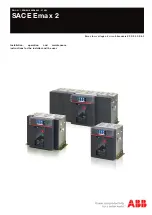
27
Instruction Book
IB182917EN September 2018 www.eaton.com
DHP-VR
+
VR-Series
+
Replacement Circuit Breaker
SECTION 5: INSPECTION & INSTALLATION
m
DANGER
BEFORE PLACING THE CIRCUIT BREAKER IN SERVICE, CAREFULLY FOLLOW
THE INSTALLATION PROCEDURE BELOW AND THE SAFE PRACTICES SET
FORTH IN SECTION 2. NOT FOLLOWING THE PROCEDURE MAY RESULT
IN INCORRECT CIRCUIT BREAKER OPERATION LEADING TO DEATH,
SEVERE PERSONAL INJURY, EQUIPMENT DAMAGE AND/OR IMPROPER
OPERATION.
When the circuit breaker is first commissioned into service and each
time the circuit breaker is returned to service, it should be carefully
examined and checked to confirm it is operating correctly per the
guidelines in this instruction booklet.
5.1 EXAMINATION FOR DAMAGE
Examine the circuit breaker for loose or obviously damaged parts.
Never attempt to install nor operate a damaged circuit breaker.
5.1.1 NAMEPLATE VERIFICATION
Verify the information on the new VR-Series
+
nameplate matches the
information on the purchase order. If any discrepancies exist, notify
Eaton’s Power Breaker Center for resolution prior to proceeding.
5.2
SURE CLOSE
MECHANISM ADJUSTMENT
m
DANGER
FOR ALL CIRCUIT BREAKER COMPARTMENTS EQUIPPED WITH
MECHANISM OPERATED CELL (MOC) SWITCHES, THE STEPS OUTLINED IN
THIS SECTION MUST BE PERFORMED BEFORE INSTALLING A VR-SERIES
+
REPLACEMENT CIRCUIT BREAKER. FAILURE TO COMPLY COULD CAUSE
DEATH, SEVERE PERSONAL INJURY, EQUIPMENT DAMAGE AND/OR
IMPROPER OPERATION.
All type DHP-VR
+
circuit breakers utilize the
SURE CLOSE
mechanism
to control kinetic energy transfer and closely mimic the dynamics and
velocities of older circuit breakers. It is imperative that this mechanism
be adjusted to compensate for the force of the MOC switch mounted
in the circuit breaker compartment.
The circuit breaker has been factory adjusted to operate one
mechanism operated cell (MOC) switch in the circuit breaker
compartment. This means that for applications with either no MOC
switch or one MOC switch, no field adjustments are required.
Finally, the
SURE CLOSE
mechanism provides an effective way to
evaluate the condition of the MOC in the circuit breaker compartment.
If the
SURE CLOSE
drive spring is properly adjusted, but the MOC
does not fully open or close, it is time to maintain the MOC in the
circuit breaker compartment. Maintenance usually means cleaning and
lubricating the MOC mechanism. If the MOC has seen a large number
of cycles, however, worn components may have to be replaced.
To insure the proper operation of the
SURE CLOSE
mechanism, the
MOC assembly should be cleaned and inspected for worn parts and
then lubricated. A spring force gauge should be used to measure the
forces needed to move the switch to the fully closed position prior to
inserting the circuit breaker (Figure 5.5). The differential force of the
assembly and the circuit breaker should be a minimum of 10 lbs. with
the circuit breaker having the higher recorded force. Should the forces
be less than that, proceed with the following steps to increase the
circuit breaker force:
m
DANGER
MEASUREMENTS AND ADJUSTMENTS SHOULD NEVER BE ATTEMPTED
IN AN ENERGIZED STRUCTURE. IF THE STRUCTURE CAN NOT BE
DE-ENERGIZED, THEN PROPER PERSONAL PROTECTIVE EQUIPMENT
PER NFPA 70E MUST BE WORN AT ALL TIMES WHILE GATHERING MOC
SWITCH DATA, ADJUSTING OR SERVICING THE MOC SWITCH. FAILURE TO
COMPLY WITH THIS WARNING COULD CAUSE DEATH, SEVERE PERSONAL
INJURY, EQUIPMENT DAMAGE AND/OR IMPROPER OPERATION.
Figurt 5.1. MOC Drivt Spring
To adjust the
SURE CLOSE
drive spring for a specific number of
MOC switches, proceed with the following steps:
Sttp 1 (50DHP-VR+ Modtls)e:
Position the DHP-VR
+
circuit breaker
outside the circuit breaker compartment, remove the front
cover. The
SURE CLOSE
mechanism is above the circuit breaker
element mechanism in its own compartment. The white
SURE
CLOSE
drive spring is centered in this compartment; the nut
and jam nut for making the compression setting is located on a
threaded rod.
Sttp 1 (150DHP-VR+ Modtls)e:
Position the DHP-VR
+
circuit
breaker outside the circuit breaker compartment. The
SURE
CLOSE
mechanism is located on the lower left rear of the circuit
breaker. The white
SURE CLOSE
drive spring is left aligned in this
compartment; the nut and jam nut for making the compression
setting is located on a threaded rod.
Sttp 2e:
From the factory, the drive spring comes set with adequate
force to operate one MOC switch, however, more force can be
generated. Refer to Figure 5.1 to see how that adjustment is set.
Notice that there is a nut and a jam nut on the threaded rod to
make the adjustment easy.
Sttp 3e:
Using a spring gauge, measure the force required to
operate the MOC to the fully closed position in the circuit breaker
compartment at the interface with the circuit breaker.
Sttp 4e:
With the DHP-VR
+
circuit breaker out of the circuit breaker
compartment, manually charge the closing springs and close
the circuit breaker. Measure the output of the MOC drive with a
spring gauge. This is done by pulling up on the MOC operator on
the right-hand side of the circuit breaker with the spring gauge
until the operator begins to deflect. Record the value read on the
spring gauge. The circuit breaker MOC drive force should exceed
the MOC force measured in the circuit breaker compartment by
10 to 15 pounds. If not, an adjustment is required.
Sttp 5e:
If additional output force is required, open the circuit breaker.
Loosen the jam nut on the
SURE CLOSE
spring and compress
the spring an additional .25 inches. Manually charge the closing
springs and close the circuit breaker.
m
CAUTION
WITH THE CIRCUIT BREAKER IN THE OPEN POSITION, THE SPRING
COMPRESSION SHOULD NEVER BE SET TO A DIMENSION LESS THAN 3.0
INCHES AS MEASURED IN FIGURE 5.1.
Sttp 6e:
Remeasure the MOC output spring force in the closed
position. Repeat steps 4 and 5 until the MOC forces are
adequate.
Sttp 7e:
Insert into the circuit breaker compartment.
Sttp 8e:
Operate the circuit breaker to verify the new setting.
Sttp 9e:
Repeat steps 4 through 8 until acceptable operation is
achieved.
















































